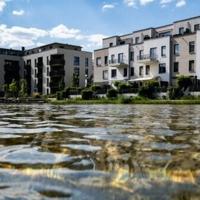In a couple of years, the large hole in the heart of Berlin will be transformed into the city’s largest reservoir, capturing water, an increasingly valuable resource.
Centuries ago, Berlin was just a swamp, but now it has evolved from a city trying to manage its groundwater to a city striving to maintain its green spaces.
“Previously, the goal was to drain rainwater to move through the city without needing rubber boots,” explained Stephan Natz, a spokesperson for Berlin’s water management services.
However, in 2018, the city shifted to a new approach of storing rainwater to combat droughts and prevent floods.
This concept of a sponge city originated in the 1970s and is now gaining popularity in urban areas worldwide.
Berlin’s old sewage system is not equipped to handle heavy rainfall, resulting in pollution and flooding in the river.
On the other hand, the city has faced water shortages due to drought conditions, further complicating the water management system.
Recognizing the value of water, Berlin is taking new measures to address its water issues.
– Race against time –
As a symbol of change, a massive water reserve is being built in central Berlin, close to the Brandenburg Gate.
This reservoir will collect rainwater and send it to a treatment plant, providing a new strategy for water management in the city.
New housing projects are now required to have rainwater collection systems to mitigate water issues.
Existing projects like Quartier 52 serve as models for sustainable water management, using ponds and green roofs to collect rainwater.
The city is working on various projects to implement the sponge city concept and encourage residents to adopt water-saving practices.
Officials acknowledge that it will take time for Berlin to fully transition into a sponge city, but they are determined to address the challenges posed by climate change.





